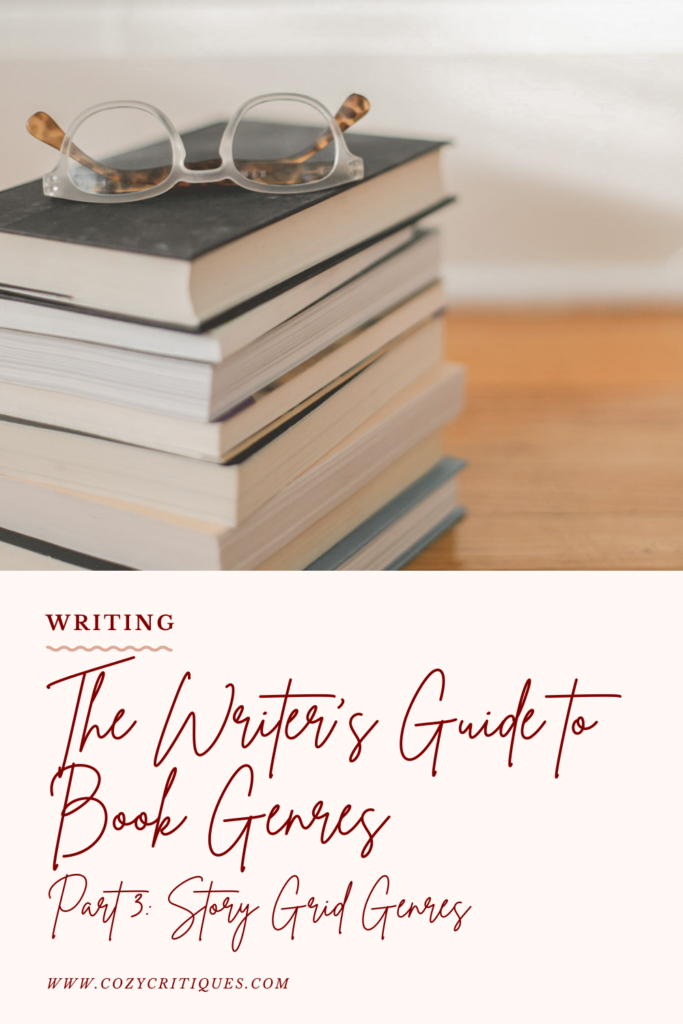This post may contain affiliate links. If you make a purchase through these links, I will earn a small commission at no additional cost to you. Read the full disclosure here.

It’s time for Part 3 of the Writer’s Guide to Book Genres!
In Parts 1 and 2, I discussed what genre is and the first category major of genre: consumer-facing genre, or reading genre.
In Part 3, I will go into the first model for plotting genres, The Story Grid method. But first, let me re-define what plotting genres are.
What are plotting genres?
Plotting genres refer to the content of the story. These are primarily used by the author to determine what kind of story they want to tell and the overall shape of that story. They can overlap with consumer-facing genres, but not every content genre has a corresponding sales category.
There are two methods of plotting genres that I like to consider when developing my story: The Story Grid by Shawn Coyne, which will be the focus of this part, and Save the Cat! Writes a Novel by Jessica Brody, which I will go into in Part 4.
What is The Story Grid?
The Story Grid is a tool used to analyze stories and provide helpful editorial comments. Developed by editor Shawn Coyne, it looks at the global story and tells the writer what is working, what isn’t, and what to do to fix any problems. The Story Grid method details the makeup of genre fiction by breaking it into five major categories illustrated on what Coyne calls the genre five-leaf clover.

The Story Grid also provides a method to analyze and outline a story’s plot, however, I will keep my focus on genre for now.
The five leaves of genre are:
- Time
- Reality
- Style
- Structure
- Content
You can read more from The Story Grid about the genre’s 5-leaf clover here.
Time Genres
Time genres indicate how the reader will experience time as they go from the beginning to the end of the story. In other words, they determine how long the story will be.
There are three categories of time genre:
- Short form: short stories, short films, individual scenes in a longer work
- Medium form: novellas, one-act plays, episodic television
- Long form: novels, three-act plays, feature-length films
You can read more from The Story Grid about time genres here.
Reality Genres
Reality genres indicate how far the audience will have to suspend their disbelief when delving into the world of your story. They put constraints on how the story’s world operates.
There are four categories of reality genre:
- Factualism: stories that exist in a world of facts of history or biography
- Realism: stories that could exist in the real world, but are imagined
- Absurdism: stories that are completely imagined and where anything could happen at any time
- Fantasy: stories that exist in a world of wonder and imagination. Fantasy stories fall into three sub-genres:
- Human: stories about worlds where fantastical elements highlight the patterns of humans
- Magical: stories about fantastical worlds with magical laws
- Science fiction: stories about worlds with imagined and possibly magical technologies
You can read more from The Story Grid about reality genres here.
Style Genres
Style genres indicate how a reader will experience the story. They set the tone for what the audience can expect.
Style can be broken down into the following sub-categories:
- Drama
- Comedy
and several mediums:
- Documentary
- Musical
- Dance
- Literary (including Poetry, Minimalism, Meta, and Postmodern)
- Theatrical
- Cinematic
- Epistolary
- Animation
You can read more from The Story Grid about style genres here.
Structure Genres
Structure genres indicate how broad, minimalist, or non-traditional the storytelling method will be. You can also think of these as what will tell the reader who or what the change in the story will affect.
There are three categories of structure genre:
- Arch-plot: Active single protagonists facing an external antagonist. Plot driven.
- Mini-plot: Passive single protagonists or multiple protagonists face internal antagonism. Each character may have their own arch-plot, but the story as a whole has a mini-plot structure
- Anti-plot: Do not follow any rules or the formal structure of storytelling
You can read more from The Story Grid about structure genres here.
“Content” Genres
In Part 1, I also referred to the broad concept of plotting genres as content genres. In the case of The Story Grid, content genres have a more niche explanation. They are what define what is contained in a story and determine the need and value at stake.
There are two subcategories of content genre:
- External Genre
- Internal Genre
The content genre also sets expectations for the reader using conventions and obligatory moments, which I will go into in Part 5.
You can read more from The Story Grid about content genres here.
External Content Genres
External content genres define what the protagonist’s external objects of desire are. Essentially the external genre is what they want. Primarily, plot-driven stories make up the external genres.
The external content genres are:
You can read more from The Story Grid about each external content genre by clicking the links above.
Internal Content Genres
Internal content genres define what the protagonist’s internal object of desire is. This is what they need rather than what they want. Primarily, character-driven stories make up the internal genres, however, a story can have both an external and internal genre.
The internal content genres are:
- Worldview: a change of the protagonist seeing the world in a different way by the story’s end
- Morality: a change in the moral or ethical character of the protagonist by the story’s end
- Status: a change in social position of the protagonist by the story’s end
You can read more from The Story Grid about the concept of internal content genres here and more about each internal genre by clicking the links above.
The Story Grid is a great introduction to plotting genres, however, there is another model for genre from Save the Cat! Writes a Novel by Jessica Brody. So stay tuned for Part 4, where I will dive into the 10 Save the Cat! genres.

Pin it!
How to Write a Novel Series
The Writer’s Guide to Book Genres
- Part 1: What is Genre
- Part 2: Reading Genres
- Part 3: Story Grid Genres
- Part 4: Save the Cat! Genres
- Part 5: Genre Conventions, Obligatory Scenes, Tropes
